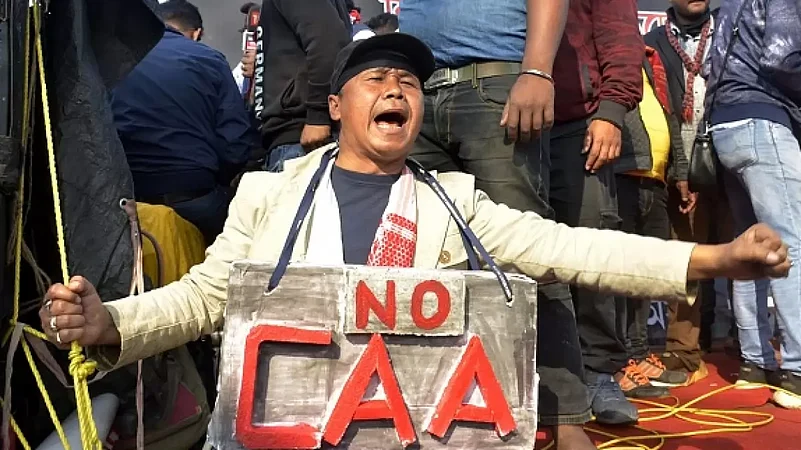The Supreme Court has completed the hearing on a batch of petitions challenging the constitutional validity of Section 6A of the Citizenship Act of 1955 and reserved the Judgement. The Union Government’s decision to formulate rules for CAA well in advance of the Lok Sabha elections raises a question on the constitutionality of the same while the Supreme Court is yet to pronounce its judgement on Section 6A or the Assam accord.
The provision outlined in Section 6A of the Citizenship Act 1955 grants the opportunity for foreign migrants of Indian origin, who arrived in Assam after January 1, 1966, but before March 25, 1971, to apply for Indian citizenship. However, several indigenous groups in Assam have raised objections to this provision, asserting that it legitimizes the unlawful entry of foreign migrants from Bangladesh into the region.
Section 6A is the incorporation of the Assam accord that was signed in August 1985 and delineated a clear categorization of individuals from Bangladesh based on their dates of entry. For instance, individuals who migrated before 1966 would be recognized as Indian citizens. Foreigners who arrived between 1966 and March 24, 1971, would undergo identification procedures as per the provisions outlined in the Foreigners Act, 1946, the Foreigners (Tribunals) Order, 1939, and similar laws.
While hearing the case, the Supreme Court issued a directive to the Ministry of Home Affairs to provide data concerning the influx of illegal migrants into Assam and the North Eastern states after March 25, 1971, following the declaration of Bangladesh's independence. Furthermore, the Court asked for detailed data disclosures under various categories. These categories included information regarding the granting of citizenship to immigrants during different timeframes and insights into the functioning of the established Foreigners Tribunals.
However, the Ministry of Home Affairs admitted before the Supreme Court that it is impossible to count the number of illegal immigrants as they enter the country in a 'clandestine and surreptitious' manner. According to the affidavit submitted by the MHA, 17,861 people were granted citizenship under section 6 A of the Act till October 2023. At the same time, 32381 persons were ousted from the right of citizenship and were declared as foreigners. Meanwhile, 334966 cases have been disposed of till October 2023. The MHA has also informed that the total number of pending cases is 97714.
Since India gained independence, illegal migration has remained a profound and emotionally charged theme in Assam's cultural fabric. The social unrest was escalated by the huge inflow of refugees followed by the Indo-Pak war in 1971. In this period in which India received the highest number of refugees, Assam only had to accommodate 298000 refugees. The agitation against illegal migration, which stirred deep-seated unrest in Assam, persisted until 1985. This turmoil culminated in the signing of the Assam Accord, which established a definitive cut-off date to determine one's entitlement to citizenship. The collective demand raised by the protesters for banning ‘illegal migration’ to Assam was manifested as clause 5 of the Accord which that ‘foreigners who came to Assam on or after March 25, 1971, shall continue to be detected, deleted and expelled in accordance with law.’
According to Prarthana Saikia, an anthropologist and faculty member at the Tata Institute of Social Sciences, the development of a sense of political rights as a citizen of Assam did not originate in opposition to colonial rule. Saikia notes that, for Assamese speakers, the concept of "foreigners" referred to migrants arriving from other regions within India. Within this context, the notion of rights was primarily expressed and articulated concerning resources, such as land. (Economic and Political Weekly, 10 June 2023).
However, many of the perceived insecurities around migration have not been supported by sufficient data. For example, the widely shared argument that the migrants have grabbed the employment opportunities of the natives is an ill-founded argument lacking data. Migrants filled roles that were either unwanted or unfeasible for the indigenous population to undertake. In the early 19th century, labourers from Bihar were brought in primarily because tea plantation owners were reluctant to engage in land cultivation. Additionally, Bengali Hindus were employed in administrative services as locals lacked the necessary expertise. Meanwhile, migrants from East Bengal, predominantly farmers, arrived with the intention of cultivating the available land.
Bengali Hindus were employed in administrative services as locals lacked the necessary expertise, according to Vani Kant Boorah, an economist who has authored research papers on the socio-political scenario in Assam. Meanwhile, migrants from East Bengal, predominantly farmers, arrived with the intention of cultivating the available land.
While hearing the petitions challenging the constitutional validity of section 6 A of the Citizenship Act, Chief Justice D Y Chandrachud observed that the humanitarian aspect of immigration cannot be undermined as India has a predominant role in liberating Bangladesh. He expressed the view that the inflow of refugees from the war-stricken East Pakistan was not solely considered illegal immigration by the then Parliament and hence Section 6A was incorporated.
The phobia of the rising Muslim population has been the foundation of challenging the constitutional validity of Section 6A.
While arguing for the petitioners, senior advocate Shyam Diwan brought in the figures of the rising Muslim population and declining Hindu population referred to in the 175th Law Commission report. However, the Chief Justice expressed his apprehension over the accuracy of the figures quoted in the report. It is pertinent to see that the affidavit submitted by the MHA later, validated this apprehension which claimed that no accurate data on immigration is available.
The discrepancies in the NRC (National Registry of Citizens) remain unresolved.
Hundreds of cases initiated by people who were thrown out of the list are still pending in various courts in Assam. The final decision of the Supreme Court is yet to come on whether Section 6A would go or would remain. Whatever the decision of the Supreme Court, the political conflicts in Assam with regard to citizenship would find no peaceful end.


























